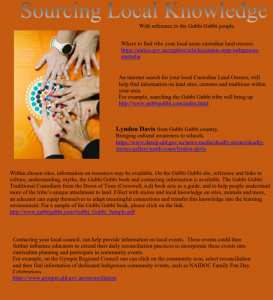1 Sourcing local knowledge
Cathy Cody
Rationale
Sourcing Local Knowledge is a digital information sheet. Designed for educators, this resource provides foundational advice and direction on how and where to source local Indigenous peoples, knowledge and stories as relevant to one’s local community through internet searches, government websites and books. This resource is specific to Gubbi Gubbi country (Australian Institute of Aboriginal and Torres Strait Islander Studies, 2019). Through internet searches and websites suggested in the resource, an educator can find relevant information to local Indigenous representative. For example, this resource identifies Lyndon Davis from Gubbi Gubbi country, who can help bring local cultural awareness to educational settings through dance, music and other Indigenous cultural practices (Department of Aboriginal and Torres Strait Islander Partnership, 2017). With Reconciliation (Reconciliation Australia, 2017b) at the forefront in creating this resource, meaningful connections to land, people and ancestry can be obtained through books identified on the resource. An educator can draw information from these books as a means to gain personal knowledge and understandings of local Indigenous culture, or the suggested children’s picture book Gubbi Gubbi Animal Friends (Stuart & Clark, 2013) in which Gubbi Gubbi language is applied. Williams (2018) brings to light cultural and linguistic differences between peoples, therefore it is essential for an educator to be conscious of local languages when introducing Indigenous dialogue into the learning environment.
Information obtained from these sites and books can be adapted and brought into the educational setting to create connections, help students to learn in new ways and understand the people’s unique attachment to land through carefully planned learning experiences (Holmes, 2018). Experiences include excursions to local Indigenous sites or the Island of Reconciliation Noosa Museum, play spaces with musical instruments, posters of local animals such as the Dala (a sacred fish to the Gubbi Gubbi people found only in the local river ways (Marohasy, 2006), and more as outlined in Gubbi Gubbi: Traditional Custodians from the Dawn of Time (Cresswell, n.d). As an educator becomes familiar with local Indigenous knowledge, one can transfer this newly gained insight into the classroom for both Indigenous and non-Indigenous children, as a means to form strong connections within one’s local community. The Department of Education, Employment and Workplace Relations (DEEWR) (2009) assert that connecting children to culture and their own identity is shaped by experiences and respect. An essential element in the EYLF (DEEWR, 2018) and basis of learning outcome two, is ‘connections between groups and community’, as this promotes belonging, being and becoming. With a commitment to closing the numerous socioeconomic gaps between Indigenous and non-Indigenous Australians, educators have a critical role in providing learning opportunities to embrace and implement cultural connections and belonging within one’s curriculum (DEEWR, 2009) which is abundant in this resource.


